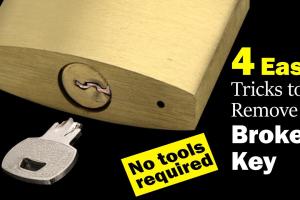The Ultimate Guide on How to Safely Remove a Broken Key from a Lock

-
Quick Links:
- Introduction
- Understanding the Problem
- Tools You Will Need
- Method 1: DIY Key Extraction Techniques
- Method 2: Using Locksmith Tools
- Method 3: Seeking Professional Help
- Preventive Measures
- Case Studies and Expert Insights
- Conclusion
- FAQs
Introduction
Finding yourself with a broken key lodged in a lock can be a frustrating experience. It’s not just an inconvenience; it can compromise your security and access to your belongings. In this comprehensive guide, we will explore the best ways to extract a broken key from a lock, discuss tools required, and provide effective techniques ranging from DIY methods to professional locksmith services.
Understanding the Problem
Broken keys can occur for several reasons: wear and tear, using excessive force, or even a faulty lock. Understanding the problem is the first step in finding the right solution. When a key breaks, it often leaves a portion inside the lock, making it impossible to turn. This not only prevents access but can also damage the lock mechanism if not addressed properly.
Tools You Will Need
Before attempting to extract a broken key, gather the following tools:
- Needle-nose pliers
- Flathead screwdriver
- Super glue
- Key extractor tool
- Lubricant (WD-40 or graphite powder)
- Drill (in extreme cases)
Method 1: DIY Key Extraction Techniques
If you prefer to tackle the problem yourself, here are some effective DIY techniques:
1. Using Needle-Nose Pliers
If a significant portion of the key is visible, needle-nose pliers can be used to grip and pull the key out. Simply insert the pliers into the lock and grasp the key firmly, then pull it out gently. Be cautious not to apply too much force, as this can push the key further into the lock.
2. Super Glue Method
If part of the key is still accessible, you can use super glue to attach a small object (like a toothpick) to the key fragment. Allow the glue to set and then gently pull the object out. This method requires precision and patience.
3. Lubrication
Applying a lubricant can sometimes help ease the key out. Spray a small amount of WD-40 or apply graphite powder into the lock to reduce friction and attempt to pull the broken piece out with pliers.
Method 2: Using Locksmith Tools
If DIY methods fail, professional locksmith tools can be employed:
1. Key Extractor Tool
A key extractor is a specialized tool designed to remove broken keys. Insert the extractor tool into the lock, hook it onto the key, and pull it out gently.
2. Tension Wrench
A tension wrench can help apply pressure on the lock cylinder while using an extractor tool, making it easier to retrieve the broken key.
Method 3: Seeking Professional Help
When all else fails, or if you're uncomfortable attempting to extract the key yourself, contacting a professional locksmith is the best option. They possess the experience and tools necessary to safely remove the broken key without damaging the lock.
Preventive Measures
To avoid future broken keys, consider these preventive measures:
- Regularly inspect your keys for signs of wear.
- Avoid using excessive force when inserting or turning keys.
- Consider having duplicate keys made from high-quality materials.
- Maintain your locks to ensure smooth operation.
Case Studies and Expert Insights
According to a survey by the Associated Locksmiths of America, nearly 30% of homeowners have experienced a lockout situation due to a broken key. In a case study conducted by the National Locksmith Association, it was found that using professional tools increased the success rate of key extraction by 45% compared to DIY methods.
Expert locksmith John Smith suggests that "patience is essential when removing a broken key. Rushing the process can lead to more damage, making it costlier to fix."
Conclusion
Removing a broken key from a lock can seem daunting, but with the right tools and techniques, it is manageable. Whether you choose a DIY method or seek professional help, understanding the steps involved can save you time and frustration. Remember to take preventive measures to avoid future incidents.
FAQs
1. What should I do if my key breaks in the lock?
Try to extract it using needle-nose pliers or a key extractor tool.
2. Can I use super glue to remove a broken key?
Yes, you can attach a small object to the key fragment with super glue and pull it out gently.
3. When should I call a locksmith?
If DIY methods fail or if you're uncomfortable attempting the removal, it's best to call a locksmith.
4. Will removing a broken key damage my lock?
Proper techniques can minimize damage; however, improper methods can lead to further issues.
5. How can I prevent my keys from breaking?
Regularly inspect keys and avoid using excessive force when turning them.
6. What tools do I need to remove a broken key?
Needle-nose pliers, super glue, a key extractor tool, and lubricant are helpful.
7. Are there professional services for key extraction?
Yes, locksmiths specialize in key extraction and can do it safely.
8. How much does it cost to get a broken key removed?
Costs vary, but professional services typically range from $50 to $150.
9. Can I fix a broken key myself?
Yes, with the right tools and methods, many people successfully remove broken keys themselves.
10. What if the broken key is deep in the lock?
If the key is deeply lodged, it's best to contact a locksmith to avoid damage.
Random Reads
- How to remove old caulking
- How to recover data from dead laptop
- Unlock android tablet
- Uninstall discord
- How to view downloads on android
- The easiest ways to stop gifs on your web browser
- How to turn off your android phone without power button
- Top 10 deepfake apps
- Transfer files pc pc
- Transfer photos ipod pc